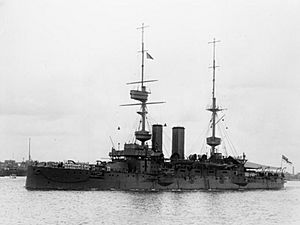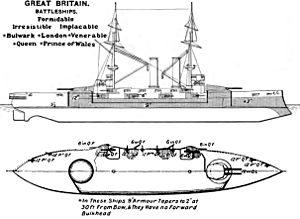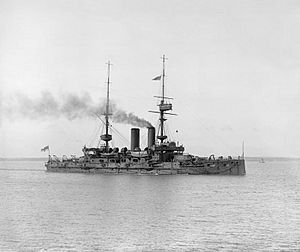HMS Bulwark (1899) facts for kids

Bulwark at anchor
|
|
Quick facts for kids History |
|
|---|---|
| Name | Bulwark |
| Ordered | 27 June 1898 |
| Builder | HM Dockyard, Devonport |
| Cost | £997,846 |
| Laid down | 20 March 1899 |
| Launched | 18 October 1899 |
| Christened | By Lady Harriet Fairfax |
| Completed | March 1902 |
| Commissioned | 18 March 1902 |
| Fate | Destroyed by internal explosion, 26 November 1914 |
| General characteristics | |
| Class and type | London-class pre-dreadnought battleship |
| Displacement | |
| Length | 431 ft 9 in (131.6 m) (o/a) |
| Beam | 75 ft (22.9 m) |
| Draught | 28 ft 2 in (8.59 m) (deep load) |
| Installed power | |
| Propulsion |
|
| Speed | 18 knots (33 km/h; 21 mph) |
| Range | 5,550 nmi (10,280 km; 6,390 mi) at 10 knots (19 km/h; 12 mph) |
| Complement | 738; 789 as flagship |
| Armament |
|
| Armour |
|
HMS Bulwark was a powerful warship built for the Royal Navy around 1900. She was one of five ships in the London class, which were a type of pre-dreadnought battleship. These ships were very important before the more modern "dreadnought" battleships came along.
Bulwark was finished in 1902. She first served in the Mediterranean Sea as a flagship, which means she carried the admiral's flag. Later, she joined the Channel and Home Fleets in Britain. From 1910 to 1914, she was kept in reserve, ready to be used if needed.
When World War I started in August 1914, Bulwark helped protect British troops crossing the English Channel to France. Sadly, on 26 November 1914, she was destroyed by a huge explosion inside the ship near Sheerness. Only about a dozen men survived, and 741 people died. The explosion was likely caused by cordite (a type of explosive) getting too hot near the ship's boilers. Very little of the ship remained, and her wreck is now a protected site.
Contents
What was HMS Bulwark Like?
The London-class battleships were ordered in 1898. This was because other countries, like Russia, were building more warships. The design for Bulwark was very similar to an earlier class of battleships called Formidable. However, Bulwark had stronger armor at the front of the ship.
Bulwark was about 131.6 meters (431 feet 9 inches) long. She was 22.9 meters (75 feet) wide. When fully loaded, she sat about 8.6 meters (28 feet 2 inches) deep in the water. The ship weighed around 15,600 tonnes (15,366 long tons).
Her crew usually had 738 sailors and officers. When she was a flagship, she carried up to 789 people.
How did Bulwark Move?
Bulwark was powered by two large steam engines. These engines turned two propellers, pushing the ship through the water. Twenty Belleville boilers created the steam needed for the engines. These boilers were connected to two tall funnels in the middle of the ship.
The ship could reach a top speed of about 33 kilometers per hour (18 knots). During tests, Bulwark even went a bit faster, reaching 33.7 km/h (18.2 knots). She could travel about 10,280 kilometers (5,550 nautical miles) at a slower speed of 18.5 km/h (10 knots) before needing more coal.
What Weapons did Bulwark Have?
Bulwark's main weapons were four huge 305 mm (12-inch) guns. These were placed in two gun turrets, one at the front and one at the back of the ship.
For smaller targets, she had twelve 152 mm (6-inch) guns. These were placed in armored sections called casemates along the sides of the hull.
To defend against small, fast torpedo boats, Bulwark carried sixteen 76 mm (3-inch) quick-firing guns. Some of these were on the main deck, and others were in the central part of the ship. She also had six smaller 47 mm (3-pounder) guns.
Like many battleships of that time, Bulwark also had four 450 mm (18-inch) torpedo tubes hidden below the waterline. Two were on each side of the ship.
How was Bulwark Protected?
Bulwark had strong armor to protect her. Her main armored belt, which ran along the waterline, was 229 mm (9 inches) thick. The armored walls at the back of this belt were 229 to 305 mm (9 to 12 inches) thick.
The main gun turrets had 203 mm (8-inch) thick armor on their faces. They sat on top of 305 mm (12-inch) armored bases called barbettes. The smaller 6-inch guns in the casemates were protected by 152 mm (6 inches) of Krupp steel.
The conning tower, where the ship was commanded, had very thick sides, 356 mm (14 inches) thick. The ship also had three armored decks, ranging from 25 mm (1 inch) to 64 mm (2.5 inches) thick.
Building and Early Years
Bulwark was named after a strong part of a ship's side. She was the fourth Royal Navy ship to have this name. Her construction began at HM Dockyard, Devonport, on 20 March 1899. She was launched on 18 October 1899 by Lady Harriet Fairfax.
The ship was finished in March 1902. She cost about £997,846 to build, plus another £167,970 for her weapons. Bulwark officially joined the navy on 18 March 1902. Her first job was with the Mediterranean Fleet.
Serving in the Mediterranean (1902–1907)
Bulwark left England in May 1902 and sailed to Malta, which was a British naval base. In August, she was the flagship for a group of ships visiting the Aegean Sea. During an exercise, another battleship, Formidable, accidentally bumped into Bulwark, causing minor damage.
In April 1903, King Edward VII visited Bulwark and reviewed the fleet. The German Emperor, Kaiser Wilhelm II, even took temporary command of Bulwark as an honorary admiral in April 1904.
In October 1904, the Mediterranean Fleet was called back to Malta. This happened after the Russian Baltic Fleet mistakenly fired on British fishing boats in the North Sea. The fleet prepared for war, but the situation calmed down. In December, Bulwark was ordered back to England.
She was recommissioned in January 1905 and returned to Malta. In June, Admiral Lord Charles Beresford made Bulwark his flagship. The ship had a long refit (repair and upgrade) in Malta until February 1906. During this time, she received new equipment to help spot targets.
In 1906–1907, some of her smaller guns were moved to better positions on the ship. In January 1907, Bulwark returned to Portsmouth, England, and was taken out of service for a short time.
Home Fleet Service (1907–1914)
Bulwark was recommissioned in February 1907. She became the flagship for the Nore Division of the Home Fleet. She visited Norway and Scotland and was part of a fleet review by King Edward in August.
In October 1907, Bulwark ran aground twice in the North Sea while trying to avoid fishing boats. She was able to free herself but needed repairs. These repairs and a long refit lasted until March 1908.
In May 1908, Captain Robert Falcon Scott, famous for his Antarctic explorations, became her captain. In August, Bulwark was decommissioned (taken out of service) and then recommissioned the next day with a smaller crew. She was then moved to the Channel Fleet in October.
From August to December 1909, Bulwark underwent another refit. In February 1910, she was placed in reserve with a small crew, serving as a flagship for a vice-admiral. She took part in annual naval exercises in July.
In April 1911, Bulwark was again taken out of service and then recommissioned the next day with a small crew. She was present at the Coronation Fleet Review for King George V in June. From September 1911 to May 1912, she had a major refit.
During sea trials in May 1912, the ship grounded twice, damaging her bottom. Repairs were finished by the end of the month. In June, Bulwark was assigned to the 5th Battle Squadron. She was not very active for the rest of 1912 and early 1913.
In May 1914, King Christian X of Denmark visited Bulwark. From May to July, she had her annual refit. On 15 July, the fleet was ordered to mobilize (get ready for action) as part of Britain's response to rising tensions in Europe. The fleet then conducted exercises.
World War I and the Explosion
When World War I began, Bulwark and her squadron were based at Portland. Their job was to protect the English Channel. After helping transport British troops to France in August, Bulwark stayed in Portland.
In November, Bulwark moved to Sheerness because there was concern about a possible German invasion of Britain.
The Explosion of Bulwark
On 26 November 1914, at about 7:53 AM, a huge explosion tore Bulwark apart. She was anchored in the River Medway, near Sheerness. All the ship's officers died, and only about a dozen sailors survived. In total, 741 men were lost. This included members of a navy band who were playing on board. Only about 30 bodies were ever found.
This accident is the second worst accidental explosion in UK history in terms of lives lost. The explosion of the battleship Vanguard in 1917 was the only one worse.
A naval investigation was held on 28 November. They concluded that the explosion was not caused by a torpedo or a mine. Witnesses saw a flash of flame near the back turret, followed by one or two quick explosions. This is different from an explosion outside the ship, which would cause a huge column of water.
Evidence showed that ammunition magazines were being reorganized that morning. This meant that at least 30 explosive charges (cordite) were left exposed in passages between the magazines. The magazine doors were also left open when the crew went to breakfast. These passages also held hundreds of shells. The investigation believed that the cordite charges were placed against a wall of a boiler room. As the boilers heated up, the wall got hot, igniting the cordite. This then set off the nearby shells and spread to the main ammunition magazine, causing the massive explosion.
The Wreck Site
On 29 November, divers explored the wreck. They reported that the front left part of the ship was blown off and lay about 15 meters (50 feet) east of where the ship was anchored. The front right part was about 9 meters (30 feet) further away. The rest of the ship was completely torn apart, and no other large pieces were found. One of the large 12-inch guns was found far from the ship and later recovered.
The wreck of Bulwark is now marked by special buoys. In 2008, it was made a controlled site because it is military remains. This means that diving on the wreck is generally not allowed without special permission.
Remembering the Lost
A memorial for those lost on Bulwark and another ship, the minelayer Princess Irene (which also exploded accidentally), was put up at the Dockyard Church in Sheerness in 1921.
Victims from both ships are also remembered at the Naval War Memorial at Southsea. Another memorial is located in Woodlands Road Cemetery, Gillingham, Kent, in the Naval Burial Ground.





